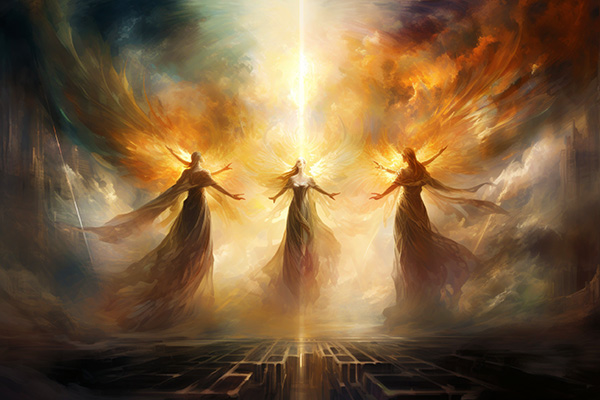spiritual teachings
The Role Of Free Will In Psychic Readings
 Free will is a common theme in psychic readings. People often wonder how much of their life is predetermined and how much they control their own future, destiny and happiness.
Free will is a common theme in psychic readings. People often wonder how much of their life is predetermined and how much they control their own future, destiny and happiness.
The truth is that our free will not only shapes our daily lives – it’s also at the core of who we are as spiritual beings on a human journey. Free will is inescapable in our lives. This is why it is a central theme in almost every spiritual, religious, and wisdom tradition.
Whether it’s the concept of karma in Hinduism and Buddhism, the moral responsibility to follow divine guidance in Christianity and Judaism, or the pursuit of virtue and inner peace in Stoicism and Taoism, the concept of free will has shaped our understanding of personal fulfillment, spirituality, and destiny since the dawn of humanity.
While interpretations of free will may vary, its presence in our lives is undeniable and determines how we experience life – unless, of course, one subscribes to an atheistic worldview that denies any higher power or spiritual framework for our existence. But even atheists must admit that their lives are also very much determined by their own choices and decisions.
We all have the inner power to shape our lives through our thoughts, beliefs, choices and actions. But with this freedom comes a great responsibility: karma. The ability to create our reality and shape our future has ripple effects that affect not only our own lives, but everything and everyone in the universe.
One of the great questions surrounding free will is the relationship between fate and personal freedom. Many spiritual beliefs hold that our lives unfold according to a divine plan or cosmic blueprint. But if everything is predestined, ordained by a higher power, and happens by divine design, why do we have the ability to make our own life choices at all? Why do we have free will if our lives are already set in stone?
The Spiritual Wisdom Of Letting Go
 I sometimes do readings for clients who feel they have to control absolutely everything in their lives. They are rarely calm, rarely happy, always frazzled. There’s a constant tension around them, a palpable anxiety, as if they’re always one step away from a meltdown, or even a complete breakdown.
I sometimes do readings for clients who feel they have to control absolutely everything in their lives. They are rarely calm, rarely happy, always frazzled. There’s a constant tension around them, a palpable anxiety, as if they’re always one step away from a meltdown, or even a complete breakdown.
Many of us have experienced this feeling or seen it in others – the compulsion to control every outcome, every detail, believing that by sheer force of will we can make life bend to our wishes.
But here’s the thing: life has a way of moving on its own, whether we like it or not. And often, the more we try to grasp and hold on, the more things slip out of our control.
A song that often comes to mind when I think about this is the song Let It Be by the Beatles. Let it be, let it be. There will be an answer, let it be. This timeless classic is a simple yet powerful reminder of the peace that can come from stopping to resist and simply allowing things to unfold as they are meant to.
Letting go is not about giving up; it’s about trusting that life has a rhythm, a universal flow, and when we align ourselves with it, life becomes infinitely more peaceful and enjoyable.
In my work as a psychic consultant, I’ve found that those who feel the need to control every aspect of their lives often carry a heavy burden of stress. They struggle to find joy because they are too preoccupied with micromanaging every little detail. Life becomes a series of hurdles and challenges, and instead of going with the flow, they are constantly swimming against the current. It’s exhausting and soul-destroying.
The Ancient Art Of Facial Reading
 Physiognomy is an ancient belief system that the face reveals the hidden truths of the mind, body, and spirit. In many cultures, the face is seen as a reflection of the soul or inner self.
Physiognomy is an ancient belief system that the face reveals the hidden truths of the mind, body, and spirit. In many cultures, the face is seen as a reflection of the soul or inner self.
This belief that a person’s physical characteristics, such as the shape of their face, eyes, or nose, can reveal something about their inner nature has roots in various ancient cultures and has been practiced for thousands of years. In some esoteric traditions, facial characteristics are believed to also reveal past life influences and karmic imprints.
The face is more than just a reflection of our emotions; it is a map of our physical health, life experiences, and even our spiritual state. By observing our facial features and learning to interpret their subtle messages, we can gain valuable insights into our health and well-being.
One of the earliest and most detailed systems of face reading comes from Traditional Chinese Medicine (TCM). Chinese face reading, or Mian Xiang, dates back more than 3,000 years. Practitioners view the human face as a map of a person’s life, health, and destiny. They divide the face into different areas, each corresponding to different internal organs and emotional states. Facial analysis is used to diagnose imbalances in the body and mind.
Physiognomy was also practiced in ancient Greece. The philosopher Aristotle (384-322 BC) wrote about it, arguing that certain facial features could indicate personality traits and that there was a connection between a person’s appearance and their character. Greek scholars believed that external features, such as facial structure, could provide insight into a person’s moral and psychological makeup.
Are You On The Karmic Path Of Grace?
 Every step we take in life shapes not only how we feel, but also where we end up in life and how others respond to us.
Every step we take in life shapes not only how we feel, but also where we end up in life and how others respond to us.
Sayings such as “you reap what you sow,” “what goes around comes around,” and “your vibe attracts your tribe” represent the complex interplay between our choices and actions and the reality we experience each day.
This is known as the universal law of cause and effect, also known as the spiritual principle of karma. Every choice we make has consequences, whether seen or unseen. Every action we take – whether physical, mental, emotional or spiritual – has a corresponding result or consequence.
Nothing in life happens by accident. Our values, beliefs, mindset and attitude all help to shape our life path and destiny. Our choices, behaviors, and even our thoughts have a ripple effect. Our free will choices ultimately determine our life journey and the legacy we will someday leave behind.
In essence, the energy or intent behind our actions affects the results we experience in life. Positive actions attract positive results, while negative actions can lead to challenges or difficulties. Over time, the cumulative effect of these causes and their consequences determines the course of our lives, affecting relationships, opportunities, and personal growth.
For this reason, it is essential that we be mindful of everything we say and do. We must cultivate self-awareness and take personal responsibility because every step we take affects our future and our destiny.
Reconnecting With Your Inner Light
 These days, it’s easy to feel lost, anxious, or just plain drained. We juggle the pressure to succeed, increasing isolation, endless app notifications, and even a creeping sense of loneliness or hopelessness.
These days, it’s easy to feel lost, anxious, or just plain drained. We juggle the pressure to succeed, increasing isolation, endless app notifications, and even a creeping sense of loneliness or hopelessness.
It’s no wonder so many of us feel overwhelmed and disconnected from our true selves and the deeper source of wisdom within that illuminates our lives. Instead of feeling alive and vibrant, for many people it’s just a matter of getting through the day.
But here’s the good news: There is a way out of this gray fog, and it doesn’t involve a fancy retreat or running away to join the circus.
It’s about reconnecting with the light within you-the spark of divinity that’s always been there. Once you tap into that, everything changes. You begin to feel grounded, peaceful and purposeful. Life becomes richer, more joyful, and you’ll find yourself smiling a lot more!
The spiritual concept of “light” is central to many Eastern wisdom traditions. In Hinduism, for example, “light” symbolizes divine knowledge, truth, and the divine self (atman). The famous Sanskrit phrase “tamaso mā jyotir gamaya” (lead me from darkness to light) from the Brihadaranyaka Upanishad refers to our innate desire for enlightenment and spiritual knowledge.
The concept of enlightenment (bodhi), metaphorically symbolized by light, is also central to Buddhism. In achieving enlightenment, one is said to attain wisdom and freedom from the darkness of ignorance.
How To Deal With Spirit Presence In Your Home
 Spirit energies are around us all the time in all shapes and forms. Many people have experienced, or at least know someone who has, a spirit presence or paranormal activity in their home.
Spirit energies are around us all the time in all shapes and forms. Many people have experienced, or at least know someone who has, a spirit presence or paranormal activity in their home.
These encounters can range from subtle to intense, and the nature of the experience often varies greatly depending on the person’s beliefs, fears, and openness to the supernatural.
For some, the presence of a spirit is a source of terror, while for others it is a comfort, like being in the presence of an old friend. Then there are those who scoff and laugh at the very idea that a ghost could exist.
These varied responses highlight an important question: why do people have such different experiences with spirits?
In my experience, it depends on two main factors: a person’s beliefs and attitudes about spirituality and the supernatural, and the nature of the spirit presence itself, whether it is benevolent or malevolent.
My grandmother came to me within three days of her death to tell me she was okay. She gave me a sense of peace and I didn’t see her again. Years later, my mother also came to me to tell me that she was okay and that all was well where she was. It was also a one-time visit.
But with my stepson, who committed suicide, and my father, it was different. He started showing up at his former house (he had left a wife and two beautiful boys) on a regular basis. He would turn on the lights or the faucet. In the middle of the night she would hear our grandchildren talking and giggling in one of their rooms. They were only two and three years old when he died. She went to investigate, thinking they were up to no good, but only one of them was in the room. When she asked who he was talking to, her boy said, “Daddy was here.”
